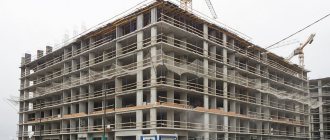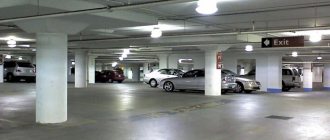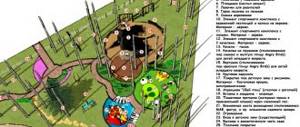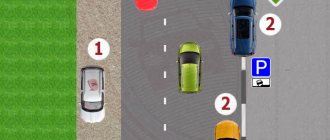What types of parking lots are there for cars? What are the features of developing parking projects, industrial design, scope of work and regulatory regulation.
Design of parking lots and lots is one of the areas of design activity
in Moscow, Moscow region and other cities of Russia. Professional development of drawings, diagrams, engineering studies of land plots, qualified staff - there are all the components for the high-quality provision of design services. Regardless of the complexity and scope of work, each parking structure must comply with regulatory requirements and standards: SP 113.13330.2012, SNiP 21-01-97, GOST R 52290-2004, GOST 21.101-97, GOST R 21.1101-2013.
Rules and regulations for car parking design
General design standards:
- Multi-storey structures for accommodating cars should have no more than 9 floors going up and no more than 2 floors underground;
- The plan should include office and living quarters for personnel, equipment rooms, and sanitary facilities. Their number and composition are determined by the design assignment;
- It is allowed to place parking terminals, cash machines and points on the site, but the installation of trading trays and kiosks is prohibited.
The nuances of designing a parking lot floor:
- Parking lots located at ground level must have a solid surface and slopes;
- If you place a parking lot on a flat rooftop, then it must meet all technical requirements. For example, the top layer should be made of fire-resistant materials that do not conduct electricity.
Pedestrian safety fencing:
- The parking lot must be fenced with a steel mesh at least 1.2 meters high. If it is located on the roof, then the height of the fence is determined by the technical specifications;
- Temporary parking lots cannot be fenced off, unlike automated parking lots.
Traffic management, entry and exit
- It is necessary to organize traffic (one-way or two-way) using markings, to separate pedestrian and transport zones as much as possible;
- Temporary parking: separate entry and exit are needed for one-way parking lots with 20 spaces or more and two-way sites with 50 spaces or more. In other cases they may be combined. Entry and exit must be at least 15 meters apart;
- Permanent storage: with a capacity of 50 cars or more, sites must have at least 2 exits located on opposite sides of the parking lot. One of them must be working, and the other emergency;
- All entry restrictions must be approved by the traffic police!
Design of communications for parking areas
The project necessarily includes engineering systems (cable networks), fire-fighting water supply systems, heating, ventilation, lifting electrical equipment (elevators, lifts, escalators), as well as the “Environmental Protection” section.
We create our projects in accordance with all safety requirements! Do you need safe, convenient and modern parking? Contact us!
We design parking lots and parking lots: Part 1 General requirements
The topic of designing car parks and parking lots is quite extensive. I decided to divide it into 3 parts. In the first part, I will outline the general requirements for the design of car parks and parking lots. The second part will be devoted to calculating the required number of parking spaces for parking lots or parking lots. And in the third part we will consider the requirements for the width of fire breaks between car storage areas and various buildings and structures.
Terminology: parking or parking?
To complete the project, you need to clearly understand the difference between the concepts of parking and parking, because the requirements in the regulatory documentation for them are different. TKP 45-3.01-116-2008 and TKP 45-3.03-227-2010 give the following definitions:
Car parking (parking): A parking place for vehicles, which is a section of the roadway, street of a populated area or adjacent territory , organized in accordance with the Decree of the President of the Republic of Belarus “On streamlining the work of car parks and car parks” dated October 3, 2006 No. 589, “Rules of the Road”, “Rules for the organization (construction), operation of car parks and car parks and their use”, as well as current TNLA.
Parking
Car parking (parking lot): A parking place for vehicles, which is a specially equipped single- or multi-level engineering structure (garage, parking lot) intended for storing vehicles and organized in accordance with the Decree of the President of the Republic of Belarus “On streamlining the work of car parks and car parks” " dated October 3, 2006 No. 589, "Road Rules", "Rules for the organization (construction), operation of car parks and car parks and their use", as well as current TNLA.
I recommend that you remember them, or rather, understand the difference; it definitely won’t be superfluous.
The dimensions of parking spaces for both parking lots and parking lots are as follows:
for passenger cars - from 2.5x5.0 to 2.5x5.5 m (depending on the availability of free territory and the purpose of the facility where parking is located);
for special vehicles driven by a disabled person with impaired musculoskeletal system functions or for transport transporting such a disabled person - 3.5x8.0 m;
for trucks - 3.0x8.0;
for road trains - 3.5x20.0;
for tourist buses - 3.5x15.0 m.
Places for car storage must be located within the area allocated for the development of this facility. Car parks and parking lots are located in separate areas and in inter-highway areas. In this case, parking lots are located within the red lines of streets with additional lanes 3 m wide in pockets (widenings) of the roadway, on side dividing strips with a depth of 2.5 to 5.5 m, depending on the adopted layout of vehicles. The picture shows a possible layout of parking spaces in the parking lot. Please note that if it is necessary to enter a parking space using diagonal parking, its width and length are increased by 0.5 and 2 m, respectively. And if you still need to complete a traffic management plan (TRAS): apply markings and place signs, then this is done in accordance with STB 1300-2014.
The main principles of designing parking lots and parking lots
During design, we take into account a set of rules and principles that help us develop modern, efficient car parking.
Firstly, when carrying out design work, it is necessary to achieve the optimal ratio of the occupied area and the number of parking spaces. In this case, the parking should be coordinated with the existing transport infrastructure and fit into the existing set of objects and buildings nearby.
The second point is the use of modern equipment, engineering and technical communications. Much here depends on the construction budget, but in any case it is worth trying to equip the parking lot with modern systems as much as possible.
It is also important to provide special conditions for people with disabilities, plus take into account all environmental requirements.
Get an accurate estimate
Managers of our company will answer your questions.
You can order a calculation in several ways:
- By phone: +7
- Send a letter by email
Get a quote
Renting a parking area
Question: An organization leases office space in a building it owns and plans to lease out areas of the territory adjacent to the building for parking tenants’ cars with the conclusion of rental agreements for parking spaces. What permits must be obtained and what formalities must be observed to enter into such agreements? In what cases can these agreements not be concluded?
Answer: The procedure and conditions for concluding a lease agreement depend on what property is being leased: a parking space or a plot of land.
First of all, it should be noted that it is necessary to distinguish between such objects of civil rights as a land plot and a parking space. Transactions with land plots are carried out in accordance with the CoL. In turn, a parking space is an object of real estate, the lease of which is carried out in accordance with the Civil Code.
A parking space is a parking space intended to accommodate a vehicle and is part of a permanent structure (building, structure, including a parking lot), owned by a legal entity or individual and registered as an object of real estate in accordance with the rules established by the legislation on state registration of real estate , rights to it and transactions with it for non-residential isolated premises.
Thus, in order to lease a parking space, it must physically exist and be registered as an object of real estate along with the emergence of ownership rights to it in the organization. If this condition is met, in order to lease a parking space, it is sufficient to conclude a lease agreement in simple written form in accordance with the Civil Code and other legislative acts.
If we are talking about leasing only part of the territory adjacent to the building, then we cannot talk about concluding a lease agreement for a parking space, since the latter as an object of civil rights does not exist in this case. The land plot is subject to lease.
It should be noted that a divisible land plot is one that can be divided into parts, each of which, after division, forms a new land plot.
Thus, part of the land plot is not an independent object of civil rights with which transactions can be made. A lease agreement can only be concluded in relation to a land plot registered as a real estate property and having boundaries established on the ground.
The possibility of dividing a land plot into parts for the purpose of subsequently leasing its parts as independent land plots also depends on the right to which the land plot belongs to the organization. Citizens and non-state legal entities of the Republic of Belarus who have privately owned land plots may be lessors of these land plots, provided that their intended purpose is preserved and subject to the restrictions established by the Code of Laws. The KoZ does not provide for the possibility of leasing a land plot owned by an organization with the right of permanent or temporary use.
Consequently, a land plot can be leased by an organization only if it belongs to it by right of ownership. Another condition that must be met when renting out a land plot is maintaining its intended purpose.
A land lease agreement is concluded in writing and is subject to state registration in the manner established by the legislation on state registration of real estate, rights to it and transactions with it.
The list of documents that must be submitted to the territorial organization for state registration of real estate, rights to it and transactions with it for state registration of a newly formed land plot and a lease agreement for such a plot is provided in clause . 17.1 of the list of administrative procedures No. 156.
Thus, to rent out a parking space you need:
1) state registration of a parking space as an object of real estate;
2) conclusion of a lease agreement in writing.
To lease a land plot you need:
1) state registration of a land plot as an object of real estate;
2) conclusion of a land lease agreement;
3) state registration of the specified lease agreement.
Design of parking structures
When designing parking lots, we take into account several factors:
- transport accessibility;
- the presence of buildings around the parking area;
- level of infrastructure development;
- compliance with fire and technical safety measures (GOST 12.1.004-91);
- the ratio of the size of the parking lot to the number of spaces for cars;
- requirements for vehicle storage conditions;
- organization of traffic of vehicles and pedestrians;
- number of parking levels.
Designing a parking lot: typical mistakes
Category "For the designer"
E.V. Sinitsa, chief specialist of ENEKA ODO
In the vast majority of cases, parking lots are an integral part of design decisions for the construction of buildings or their improvement. Not a single industrial enterprise, shopping center or residential building can function without parking for vehicles.
LEGAL REGULATION
When developing the “Environmental Protection” section of the design documentation for the construction of parking lots, one should be guided by the following main regulatory documents and legal acts:
•TKP 45-3.01-116-2008 (02250) “Urban planning. Settlements. Planning and development standards"[1];
•TKP 45-3.03-227-2010 (02250) “Streets of populated areas. Construction design standards"[2];
•SNB 3.03.02-97 “Streets and roads of cities, towns and rural settlements”[3];
•TKP 45-3.02-25-2006 (02250) “Parking garages and parking lots. Design standards"[4] (hereinafter referred to as TKP 45-3.02-25-2006);
•Sanitary norms and rules “Requirements for sanitary protection zones of organizations, structures and other objects that have an impact on human health and the environment” [5] (hereinafter referred to as SanPiN);
•EkoNiP 17.01.06-001-2017 “Environmental protection and natural resource management. Environmental safety requirements”[6] (hereinafter referred to as EcoNiP 17.01.06-001-2017).
Stages of parking lot design
The design process of parking complexes consists of three major stages:
- Pre-design work. The work begins with communication with the customer. Based on the results of the survey, technical specifications for the development of the project are formed. Then, based on the technical specifications, the engineer prepares a concept for the object, which can be made either in the form of a sketch or in the form of a three-dimensional rendering.
- Development of design solutions. After the client chooses and approves one of the conceptual proposals, we begin to formulate design solutions. At this stage, both standard and individual solutions can be used - it depends on the project budget and the client’s wishes.
- Development of working documentation. Design solutions are approved by expert organizations, after which, based on them, a specialist develops a set of working drawings - working documentation.
ERROR 1. SANITARY GAP FOR CAR PARKING IS INCORRECTLY DEFINED
According to clause 2 of SanPiN, a sanitary gap is a distance from an object with a special regime of use, which provides a sufficient level of safety for public health from harmful effects (chemical, biological, physical) at its border and beyond it, has a sanitary protection zone regime (hereinafter — SPZ) with the exception of the requirement to develop a SPZ project.
In Appendix 2 to SanPiN, sanitary gaps from car parks and car parks with the same number of parking spaces to objects for various purposes are similar[7].
To correctly determine the sanitary gap of a car park, the environmental designer needs:
1. Establish the number of parking spaces in accordance with clause 22 of SanPiN, according to which, if several parking lots or parking lots are located in adjacent areas, located at a distance of no more than 15 m from each other, the sanitary gap from them is determined taking into account the number of cars - spaces in adjacent car parks or car parks. That is, even if two parking lots are located at a distance from each other, but this distance does not exceed 15 m, then the sanitary gap from such parking lots is established as a common one, taking into account the total number of parking spaces.
2. Determine all objects located near the parking lot, to which the distance is calculated in accordance with Appendix 2 to SanPiN. Such objects include:
- residential buildings;
- land plots (for estate type of development);
- institutions of preschool education, general secondary education;
- recreation areas (zones), children's playgrounds;
- healthcare organizations providing medical care in inpatient settings;
- open and semi-open physical education and sports facilities.
3. Determine the distance between the parking lot and each object to which a sanitary gap is installed. This must be done due to the fact that the size of the sanitary gap may vary for different objects. So, for example, for a parking lot with a capacity of 10 parking spaces, the sanitary gap to the facade of a residential building is set at 10 m, and to the border of the land plot in the case of a manor type of development - 6 m.
4. Establish the size of the sanitary parking gap for each object to which the distance is calculated.
When determining the size of the sanitary gap for a car park, it is important to remember that SanPiN does not provide for the possibility of reducing sanitary gaps for car parks and car parks. Therefore, if the sanitary gap for a car parking is not observed, it is necessary to either move it to the required distance or reduce the number of parking spaces to comply with the required sanitary gap.
Please note that Appendix 2 to SanPiN does not establish a sanitary gap for parking lots with a capacity of more than 500 parking spaces. In this case, the sanitary gap is determined as follows:
- if a car parking lot is located on the territory of a facility that has a basic sanitary protection zone size determined in accordance with Appendix 1 to SanPiN, then the basic sanitary protection zone size is applied for the entire facility as a whole, taking into account the car parking lot. This condition applies to all parking lots, regardless of the number of parking spaces;
- if a car parking with a capacity of 500 parking spaces is a separate facility or is part of a facility for which it is not necessary to establish a sanitary protection zone (for example, a store, a sports complex, etc.), for such a parking lot the sanitary gap is determined based on calculations of the dispersion of pollutant emissions substances into the air and levels of physical exposure. The design of the sanitary protection zone is not developed when the estimated sanitary gap is established.
ERROR 2. SOURCES OF POLLUTANT EMISSIONS INTO THE ATMOSPHERIC AIR ARE INCORRECTLY IDENTIFIED
The sources of pollutant emissions when designing vehicle parking areas are the parking lots themselves.
BY THE WAY
There are different types of vehicle parking, for example (clause 3.1 of TKP 45-3.02-25-2006):
• parking - an equipped open area intended for storing cars;
• parking garage - a building (part of a building) intended for storing cars;
• closed parking garage - above ground garage with external enclosing structures;
• open-type parking garage - above-ground garage without wall fencing or with partial fencing;
• underground parking garage - a parking garage, all floors of which are underground.
According to paragraph 3 of Art. 13 of the Law of the Republic of Belarus dated December 16, 2008 No. 2-Z “On the Protection of Atmospheric Air” [8] stationary sources of emissions are divided into organized and unorganized. Wherein:
- organized stationary emission sources include emission sources equipped with devices through which the entry of pollutants into the atmospheric air from sources of emission of pollutants is localized;
- unorganized stationary sources of emissions include sources of emissions that are not equipped with devices through which the entry of pollutants into the atmospheric air from sources of emission of pollutants is localized.











